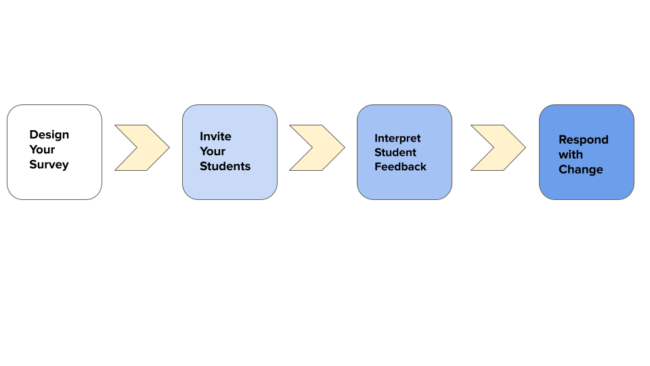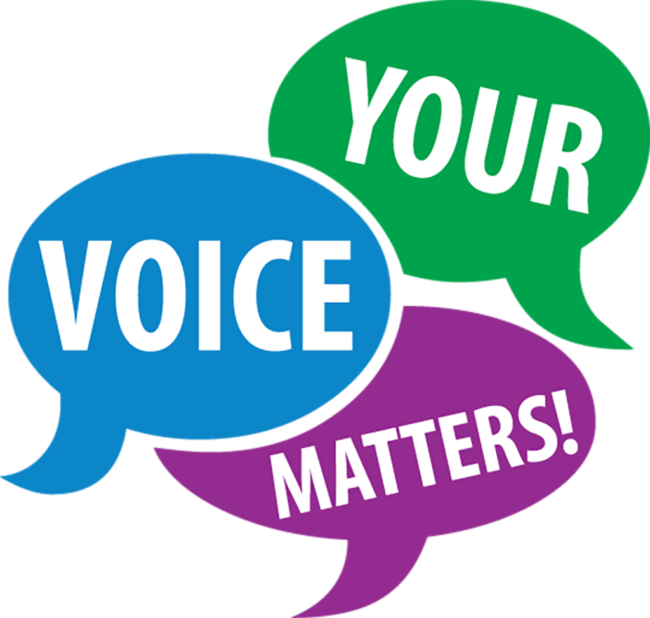How to Collect Mid-Semester Feedback of Teaching
Mid-semester feedback of teaching is a type of formative assessment that involves four simple steps:
Benefits of Using Mid-Semester Feedback:
Provide a way to see what is working and what isn’t working in your course so that it can be corrected mid-semester.
Positively impacts student/instructor relationships (especially in this unusual time of COVID-19; how are students feeling about your teaching and what they are getting out of the course).
Provides valuable insight to the student experience, perceptions, learning, and other variables (Mohanty, Gretes, Flowers, Algozzine, & Spooner, 2005; Yao & Grady, 2005).
Can easily identify remedied obstacles to learning (Yao & Grady, 2005).
Creates better understanding of the course evaluation process as a whole (Davis, 2009).
Can result in better end of semester student evaluations.
Can be customized to target specific interventions (Huxham et al, 2008).
Demonstrates an active investment in educational development and self-improvement (Nilson, 2010).
Can help build a professional network around teaching (Svinicki & McKeachie, 2011).

Step One – Design Your Survey Tool
The most common way faculty elicit feedback from students is by using a form, survey, or questionnaire, but there are many other ways, ranging from one-minute reflections to targeted focus groups, so explore approaches and use one that will provide the most meaningful feedback.
If you are planning to build a survey, at UMaine you can do so using Google Forms, Qualtrics, or using the survey tool in Brightspace. Here are few considerations.
- Make sure the survey is anonymous; if you are deploying it in a face-to-face class consider leaving the class, and having a student collect the forms.
- Include questions that will give you the most meaningful information; for many this includes a few questions about major aspects of the course.
- Use both open-ended questions and some quantitative ratings.
- Ask students to reflect on their actions as learners, along with aspects of the course.
- Elicit feedback at significant points during the semester; it does not need to be one mid-point, you can use it at the end of each unit, or after major learning activities.
- It is best to elicit feedback after an assessment has been completed so students have an idea of their performance in the course.
- Design the evaluation so that the data will be useful and actionable – take your own survey to be sure.
Need some inspiration? Explore these example questionnaires:
- Example Midterm Evaluation (University of Tennessee Chattanooga)
- Teaching Resources: Sample Midterm Evaluations (UC Berkeley)
- Mid-Course Evaluations (University of Colorado Colorado Springs)
- Mid-Term Course Evaluations (University of Ottawa)
- Mid-Semester Feedback (University of Texas at Austin)
- Mid-Semester Formative Feedback (University of Connecticut)
- Google Form Template (a template form with a variety of questions formats for inspiration)

Step Two: Invite Your Students to the Process
To genuinely invite your students into this dialogue it is important to create space for the evaluation to happen. Often mid-semester feedback tools are deployed as an “add-on,” an optional activity with no explanation of why. This approach may result in low participation and non-constructive feedback from your students.
- Make time for student feedback during your synchronous meetings, preferably at the start of a class time and be sure to leave enough time for thoughtful feedback.
- In asynchronous courses, place the activity at the beginning of a module.
- Frame it correctly, explain why it is important and why should students care.
- Let them know how you will use the feedback.
- Let them know who will benefit from their feedback.
- Provide guidance on HOW to give feedback. Here are a few great resources that can provide examples. These techniques are relevant to your mid-semester feedback forms, and your formal student evaluations of teaching.
Talking to Students about Evaluations Guidelines (Vanderbilt)
Students Helping Students Provide Valuable Feedback on Course Evaluations (UCMerced)

Step Three: Interpreting Student Feedback
Interpreting student feedback can be a challenge at times, regardless of when during the semester you are collecting it. Through this process, prepare yourself emotionally, stay positive and try to focus on the constructive feedback.
- Look for common threads, and don’t focus on outliers. (However, depending on your question, even one outlier may be indicative. For example, if your goal is to create an inclusive learning space, even one student saying they felt excluded may warrant consideration.)
- With qualitative data, read one question at a time and look for themes. Not sure how? Here is a great reference: Analyzing Student End of Course Written Comments (Scholarly Teacher).
- With quantitative data create a spreadsheet of response frequencies to help visualize trends.
- Recognize what you can and can’t change, and consider only what you have control over.
- Get perspective when needed. Harmful, hurtful or critical comments can be read by CITL staff or a colleague to help gain perspective if this happens to you.
- Identify what you will change and why.

Step 4: Responding with Change
The most important step in making this process meaningful is to actually listen to your students and adjust your course to help their learning.
- Make time in your synchronous time to discuss feedback with your students.
- Share data with your students in a way that shows you have really read and considered their feedback. (Some faculty even engage their students in interpreting and analyzing the data!)
- Discuss what you will change now, what you will change later, and what can’t be changed. Being transparent with students can generate more positive student-instructor interactions.
- Thank them for their participation.
Resources:
Angelo, T. A., & Cross, K. P. (1993). Classroom assessment techniques: A handbook for college teachers. San Francisco: Jossey-Bass.
Davis, B. G. (2009). Tools for teaching. 2nd ed. San Francisco, CA: Jossey-Bass.
Huxham, M., Laybourn, P., Cairncross, S., Gray, M., Brown, N., Goldfinch, J., & Earl, S. (2008). Collecting student feedback: A comparison of questionnaire and other methods. Assessment & Evaluation in Higher Education, 33(6), 675-686.
Mohanty, G., Gretes, J., Flowers, C., Algozzine, B., & Spooner, F. (2005). Multi-method evaluation of instruction in engineering classes. Journal of Personnel Evaluation in Education, 18(2), 139-151.
Nilson, L. B. (2010). “Evaluating and documenting teaching effectiveness.” In Teaching at its best: A research-based resource for college instructors (pp. 315-328). 3rd ed. San Francisco, CA: Jossey-Bass.
Svinicki, M., & McKeachie, W. J. (2011). McKeachie’s teaching tips: Strategies, research, and theory for college and university teachers. Belmont, CA: Wadsworth.
Yao, Y., & Grady, M. L. (2005). How do Faculty make formative use of student evaluation feedback?: A multiple case study. Journal of Personnel Evaluation in Education, 18(2), 107-126.
Zakrajsek, T. (2019). Analyzing Student End of Course Written Comments, retrieved from https://www.scholarlyteacher.com

